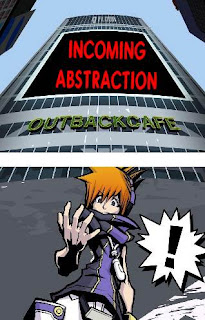When I first started playing The World Ends With You (TWEWY), I couldn't believe Square Enix made such a convoluted game for the Nintendo DS. It is as if they went out of their way to ignore the progress that games like Kirby: Canvas Curse, The Legend of Zelda: Phantom Hourglass, and even Ninja Gaiden: Dragon Sword have made. But then I thought about the kinds of games Square Enix makes, and everything became clear. Square Enix has always had a very difficult time incorporating action elements into their games. They've been trying for years, but, like with so many of their games, the few concrete mechanics they get right are drowned in a deluge of abstract RPG mechanics. TWEWY is no exception.
The World Ends With You is an action RPG. Action RPGs are typically designed with fourth tier mechanics in their base level, concrete combat mechanics before abstract mechanics are added on top. TWEWY is no different. Playing TWEWY makes me realize how shallow and laborious abstract mechanics really are. Once again, Square Enix has thrown a ton of presentation and slick style onto a few decent concrete mechanics and the world eats it up. But before I get into the mechanics, if you haven't played TWEWY or seen it, check it out here. Keep in mind, the battles take place with both screens at the same time like in the beginning of the video.

To keep things simple, I'll break the battle system down into it's component mechanics and describe them using bullet points.
Touch Screen gameplay:
- Touch screen attacks are fairly individual (each attack has a relatively unique motion) and intuitive (bullets = taps, icebergs = down to up slash etc.) However, they lack in dynamics. The hit stun and knockback from attacks are fairly uniform throughout the range different attacks.
- Like most action RPGs, the hitboxes for the characters and attacks are very loosely defined. And in TWEWY the battle space is draw in awkward quasi 3d space. The objects on the screen appear to float on top of and around each other. The bottom screen easily becomes cluttered in a mess of flashy attacks, street side objects, enemies, and the main character sprites.
- When the screen isn't cluttered, moving is as simple as touching the character and dragging him around the field. Because of the poor representation of objects and characters, in the heat of battle, moving around can become quite difficult. Sometimes I could swear I cleanly moved my character out of the way, but the game registered it as an attack instead. Otherwise, moving in this way is fairly direct and intuitive.
- Players can dodge by dragging the character quickly in any direction. This input motion overlaps with several attack inputs, and the basic moving inputs as well. Though the dodge motion is intuitive (a fast stroke triggers a fast dodge) the mechanic lacks individuality. Also, the dodge distance is fixed taking away from the mechanic's directness as well. In other words, a short, fast stroke doesn't result in a short quick dodge.
Top Screen Gamplay:
- Top screen attack combos are a string of canned attacks that are not individual. The d-pad buttons represent different stages of the current combos that the player simply navigates between limited options. The form of the attack combos are disconnected from the inputs. The d-pad directions are related to the attack directions (left or right) however because of the nature of the hitboxes, a stress is put on this mechanic. The attacks aren't dynamic and offer very little variation. A significant amount of cluttered exists because the top screen attacks are essentially a substitution standard, base level attack. This design choice adds more inputs into the game without adding any more action, dynamics, or interplay.
- Special tag team Fusion attacks can be activated after the player successfully matches the order of cards on the top screen. Guessing wrong gives players a hint at the correct order. This mechanic is just another abstract system tossed on top of the cluttered battle system design. Also, noticing the hints, and playing to this mechanic forces players to read the HUD display at the top of the top screen. Relying on abstract displays for an abstract system puts this mechanic at a high level of abstraction.
Combined Battle Mechanics:
- Enemies exist on both screens at once making paying attention to the battles on both screens at the same time very difficult. Instead of unifying the enemies and subsequently the two separate battles together through the enemies, the developers have decided to decouple the parallel enemies in two detrimental ways. The parallel enemies don't experience the same stun or knockback from attacks, and their movements aren't synchronized. Only by defeating an enemy on one screen is the parallel enemy effected. Essentially, the only thing the enemies share are hit points which keep the interplay between the two screens at a high level of abstraction.
- While fighting battles on both screens, the player can time their attacks between the two characters back and forth to build up attack combo multipliers. Because TWEWY doesn't have a wide enough range of dynamic interactions in its battle system, and the gameplay on both screens are so disconnected, this tag team mechanic is designed to unify the gameplay. Unfortunately, this abstract mechanic puts a great amount of stress on the rest of the battle mechanics. The clutter that already exists in the battle system worsens when playing to this additional mechanic.
Pre-battle Mechanics:
- Before battle players can decide if they want to manually control the character on the top screen or let the computer AI take over. A feature like this suggests that the battle system is so complex, unintuitive, and has such a high learning curve that players may need such a substantial handicap. Being able set the top screen on "autopilot" is an abstract mechanic. Forfeiting control of the game forfeits interaction and gameplay.
- At any time outside of battle, players can also adjust their character's level. By lowering the character's stats through their level, players earn a higher chance that enemies will drop good items after each battle. This mechanic gives the player the power to challenge themselves and spend less time grinding in battle to earn more items. TWEWY also lets players adjust the difficultly mode for the whole game on top of being able to adjust the character's levels. These mechanics may be effective, but they are completely removed from the form of the game let alone its few concrete mechanics. Being able to power up or down one's level isn't even compatible with the fiction of the game.
In the end, the battle system in TWEWY features one decent concrete mechanic (touch screen attacks and movement) buried under a mess of cluttered and abstract mechanics. Though getting the hang of the battle system can feel very rewarding at times, mastering any system concrete or abstract is rewarding. Being in control of chaos or a multitude of elements is a wonderful feeling. But for TWEWY, getting the hang of the battle system comes at a high learning curve mostly because of how unintuitive battling on both screens at once is and the shear volume of cluttered and abstract mechanics the player has to learn from scratch. The worst part is, the abstractions don't add depth to the gameplay. They only add complexities. Each abstract element from the card guessing mini game, passing the light puck combo system, to the top screen battling is either being executed successfully or it's not. There is no interplay between these systems, dynamic interactions/consequences from mistakes, or enough variation to each system and the basic battle mechanics to create emergent gameplay, the corner stone of action games.
Though I've only talked about the battle system of The World Ends With You, the rest of the game is equally unnecessarily complex. The game is overwrought with stats and abstract systems for just about everything you can think of. For example, characters can buy food and eat it to gain stat upgrades. But at the same time the food must be digested. When the character is eating food, they digest a little bit of food as they fight every battle. But wait there's more. Each character can only eat so much in each day of real time. So if you want to eat as much as possible, wake up early and start stuffing your face. Hold on, I'm not done yet. Each character's stomach size shrinks as they eat more and more, but then resets with each new day. But if you thought it was over, there's one more bit to it. ach character has likes and dislikes for different types of food. And this is just one abstract system out of many in the game.

Such a complex system for eating food is egregious because mastering the abstract system only gives the player higher stats in the end, which are abstractions in themselves. Mastering any of the game's abstract mechanics and systems only rewards the player with more points. More abstractions. Because the battle system has so few dynamics and interactions, all the work you put into learning and mastering the abstractions outside of battle won't show up as anything more than a higher number here and there. Also, because the dynamics are so low, understanding how to maximize one's attack power is obvious: Attack-attack-attack. In other words, use the attacks that have multiple hits so that you can effortless combo the enemies. Knockback, object positioning, and hit stun aren't factors to consider when you can optimize the game so easily.
Games like The World Ends With You prove that even some of the biggest developers have lost touch with what makes games so great. Though TWEWY has its charm, even the game's innovations aren't that significant, and it was supposed to be the fresh take on action RPGs. When you break it down, you're not really doing much throughout the entire game. The world ends with me? Too bad it didn't begin with concrete mechanics.